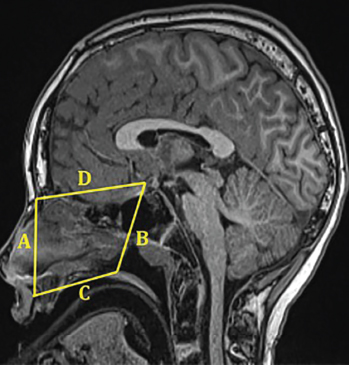What is the potential effect of the expanded endonasal approach (EEA) on midfacial growth due to surgical resection of skull base tumors in children?
Bottom line: There was no difference in midfacial growth measurements between EEA and open-route patients after three years of imaging follow-up.
Explore This Issue
February 2020BACKGROUND: Definitive treatment of pediatric skull base tumors has been traditionally accomplished via an open transcranial approach. The EEA to the cranial fossa allows for excellent visualization through an anterior midline approach. There have long been concerns that iatrogenic damage to the nasal growth zones that drive midfacial development during adolescence would result in lasting midfacial deformity.

Cephalometric analysis. Measurements included (A) anterior midface height (nasion–subspinale), (B) posterior midface height (sella–posterior nasal spine), (C) palate length (subspinale–posterior nasal spine), and (D) sella–nasion distance.
© 2019 The American Laryngological, Rhinological and Otological Society, Inc.
STUDY DESIGN: Retrospective review of 22 children undergoing craniopharyngioma resection from Jan. 1, 2003, to Dec. 1, 2014, via an open transcranial (10) or EEA (12), with three years of imaging follow-up.
SETTING: Children’s Hospital of Philadelphia, Philadelphia, Penn., USA.
SYNOPSIS: All patients had craniopharyngioma on final pathology. In the EEA group, two of 12 patients were female, and the average age at presentation was 7.92 years. In the open group, seven of 10 patients were female, and the average age at presentation was 6.4 years. Mean duration of follow-up from baseline cephalometric measurement was significantly longer in the open group. Tumor size was significantly larger in the open group (47.8 mm) than in the EEA group (37.5 mm). Open group patients were more likely to present with hydrocephalus than EEA patients. There was no significant difference in presence of cavernous sinus or suprasellar extension at diagnosis between groups. The study used established landmarks and linear measurements; the four cephalometric measurements were anterior midface height, posterior midface height, palate length, and sella–nasion distance. No significant differences were identified in any of the four measurements. Limitations include the study’s retrospective nature, relatively short duration of follow-up, and small sample size of pediatric patients undergoing an EEA.
CITATION: Parasher AK, Lerner DK, Glicksman JT, et al. The impact of expanded endonasal skull base surgery on midfacial growth in pediatric patients. Laryngoscope. 2020;130:338-342.